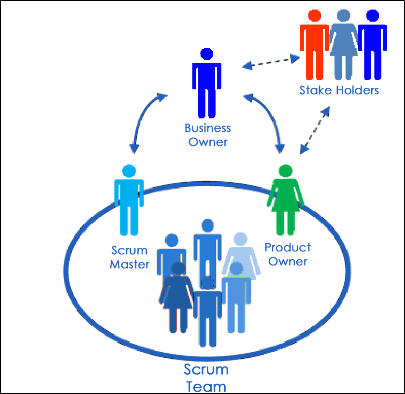Agile Scrum Roles
Scrum – A framework within which people will play roles in predefined roles
The roles can not be changed or modified because scrum immutable.
The Scrum Team consists of a Product Owner, the Development Team, and a Scrum Master. Scrum Teams are self-organizing and cross-functional. Self-organizing teams choose how best to accomplish their work, rather than being directed by others outside the team. Cross-functional teams have all competencies needed to accomplish the work without depending on others not part of the team. The team model in Scrum is designed to optimize flexibility, creativity, and productivity. The Scrum Team has proven itself to be increasingly effective for all the earlier stated uses, and any complex work.
The Product Owner
- The Product Owner is responsible for maximizing the value of the product resulting from work of the Development Team
- The Product Owner is the sole person responsible for managing the Product Backlog. Product Backlog management includes:
- Clearly expressing Product Backlog items;
- Ordering the items in the Product Backlog to best achieve goals and missions;
- Optimizing the value of the work the Development Team performs;
- Ensuring that the Product Backlog is visible, transparent, and clear to all, and shows what the Scrum Team will work on next; and,
- Ensuring the Development Team understands items in the Product Backlog to the level needed.
- For the Product Owner to succeed, the entire organization must respect his or her decisions. The Product Owner’s decisions are visible in the content and ordering of the Product Backlog. No one can force the Development Team to work from a different set of requirements.
The Development Team
- The Development Team consists of professionals who do the work of delivering a potentially releasable Increment of “Done” product at the end of each Sprint.
- A “Done” increment is required at the Sprint Review. Only members of the Development Team create the Increment.
- Development Teams are structured and empowered by the organization to organize and manage their own work. The resulting synergy optimizes the Development Team’s overall efficiency and effectiveness.
- Development Teams have the following characteristics:
- They are self-organizing. No one (not even the Scrum Master) tells the Development Team how to turn Product Backlog into Increments of potentially releasable functionality;
- • Development Teams are cross-functional, with all the skills as a team necessary to create a product Increment;
- • Scrum recognizes no titles for Development Team members, regardless of the work being performed by the person;
- • Scrum recognizes no sub-teams in the Development Team, regardless of domains that need to be addressed like testing, architecture, operations, or business analysis; and,
- • Individual Development Team members may have specialized skills and areas of focus, but accountability belongs to the Development Team as a whole.
- Team-size: Optimal Development Team size is small enough to remain nimble and large enough to complete significant work within a Sprint. Fewer than three Development Team members decrease interaction and results in smaller productivity gains. Having more than nine members requires too much coordination. Large Development Teams generate too much complexity for an empirical process to be useful.
The Scrum Master
- The Scrum Master is responsible for promoting and supporting Scrum as defined in the Scrum Guide. Scrum Masters do this by helping everyone understand Scrum theory, practices, rules, and values.
- The Scrum Master is a servant-leader for the Scrum Team. The Scrum Master helps those outside the Scrum Team understand which of their interactions with the Scrum Team are helpful and which aren’t. The Scrum Master helps everyone change these interactions to maximize the value created by the Scrum Team.
Scrum Master Service to the Product Owner
The Scrum Master serves the Product Owner in several ways, including:
- Ensuring that goals, scope, and product domain are understood by everyone on the Scrum Team as well as possible;
- Finding techniques for effective Product Backlog management;
- Helping the Scrum Team understand the need for clear and concise Product Backlog items;
- Understanding product planning in an empirical environment
Scrum Master Service to the Development Team
The Scrum Master serves the Development Team in several ways, including:
- Coaching the Development Team in self-organization and cross-functionality;
- Helping the Development Team to create high-value products;
- Removing impediments to the Development Team’s progress;
- Facilitating Scrum events as requested or needed;
Scrum Master Service to the Organization
- The Scrum Master serves the organization in several ways, including:
- Leading and coaching the organization in its Scrum adoption;
- Planning Scrum implementations within the organization;
- Helping employees and stakeholders understand and enact Scrum and empirical product development;
- Causing change that increases the productivity of the Scrum Team; and,

